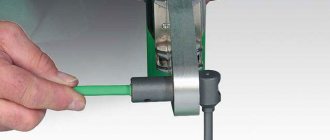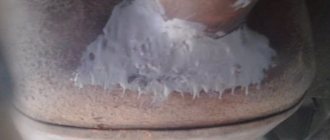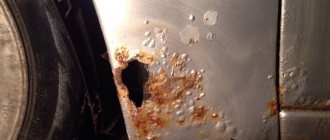A pipe fistula is a damage to the pipeline wall in the form of a crack or a through hole. Occurs in metal pipe materials due to pitting corrosion, in plastic – due to high pressure, when the type of pipes does not correspond to the design of heating or hot water supply systems.
The article below will help you independently resolve the issue of sealing fistulas in pipes. The problem of how to repair a fistula in a pipe under pressure is indeed very pressing. After all, a leak in water supply, heating, or drain pipes can occur at the most inopportune moment, and it must be resolved quickly and effectively.
First of all, you need to understand that all the proposed tips are interesting, but, unfortunately, they are not long-lasting, and the results in the future can be much worse.
Experts recommend that if a leak occurs, immediately replace the pipe products with new ones. Polypropylene pipes will help reduce financial costs.
They are not only not expensive, but also easy to install. Their installation is not complicated and is easy to do yourself. When talking about methods for sealing a leak, we mean a “breakthrough” of a small scale. If water comes out like a fountain, then there is only one way out - replacing the pipeline.
Fistula is called pitting corrosion, which is formed from partial destruction of the material, or from general old age. As a result, a hole appears through which liquid flows out.
The external visual manifestation of the fistula is swollen paint and growths of rust. Having seen such a growth, you should not rush to tear it off, because the extent of the damage underneath is not predictable.
In general, repairing pitting is not a difficult job, but, nevertheless, it also requires serious preparation.
For such events you will need (experts say that you should always have on hand):
- Clamp (a couple of pieces).
- Rubber pads (they can be easily made from any available materials such as old boots, thick rubber gloves, a bicycle tire, and so on).
- Screwdriver and bolts.
- Epoxy materials.
- Liquid for degreasing.
- Emery.
- Cold welding.
Causes of fistulas
The reasons for the formation of fistulas on a water pipe most often come down to one denominator. This is the effect of corrosion.
The most suitable temperature indicator for corrosive formations is +15 degrees. Most often, pipe rolling materials are in this mode in the spring, summer and autumn periods.
Water located in the system also accelerates corrosive destruction. Over time, rust builds up inside metal pipelines.
The metal in such products becomes thinner every year. And then the moment comes when corrosion breaks through the wall completely. The result is a leak.
This problem must be eliminated immediately, without waiting until it turns into a big nuisance. If the leak is small, then it can be sealed under pressure without turning off the water supply.
The most common problems that result in a leaking heating pipe include:
- long operating time and severe corrosion;
- poor quality installation work, poor joints;
- loads of different types on the components of the heating system.
Since water is constantly under pressure in the pipe, and air temperature changes act on it from the outside, condensation can form, which leads to oxidation of the metal and accelerates corrosion processes.
Leaks can form not only in a metal pipeline, but also in a plastic one. Naturally, the problem most often arises as a result of mechanical damage or improper installation, since this material does not corrode.
Where do leaks most often occur?
Basically, leakage occurs due to improper installation. The joints between pipes and radiators are considered especially weak.
But there is another big point - the wrong choice of material. There is no need to use polypropylene pipes intended only for cold tap water to install heating communications.
As a result, when hot water is supplied, they cannot withstand the resulting pressure, resulting in a leak.
What should you do to rid your heating system of this situation? When installing a heating system, it is recommended to use only reinforced polypropylene pipes. Most often, a leak can form at the joints at the place of the connecting seam or the connection of the pipe to the battery.
How to fix leaks in metal pipes
A fistula in a metal pipe with hot water can be quickly repaired using the following methods.
Option 1. Medical bandage and cement solution. It is cut into pieces and soaked in pre-prepared cement mortar. These bandages are wrapped around the leakage area, forming a cocoon-like structure.
Finally, the resulting structure is also covered with cement mortar. It dries in about one day.
Option 2. Pieces of rubber. Rubber is cut into strips. Each of them should be slightly longer than the circumference of the pipe.
Next, the strips are pulled tightly, wrapping the “emergency” zone, and secured with clamps. This method can be used to repair a small fistula even on a damaged section of a heating radiator.
Option 3. Table salt and bandage. As a rule, this method is used to seal pressure leaks in couplings, elbows, etc. The leaking area is wrapped in a bandage mixed with salt.
When dissolved, salt fixes micro-leakage. If we compare this method of sealing under pressure, it is immediately worth noting that it is not as reliable as the first two.
Option 4. Bandage. This method can be used for pressure pipes. The bandage is considered one of the oldest and most proven options. A small car clamp can be used for a fistula with a volume of up to 0.005 cm.
For the clamp, a strip of rubber is cut out, a couple of millimeters wider than it. The length of the strip should be one centimeter shorter than the circumference of the pipeline. The clamp is placed on the pipeline, and a rubber gasket is placed under it.
This entire structure must completely cover the fistula. Next, the clamp is tightened. During these activities, the surface at the site of corrosion must be cleaned.
Video: ways to repair a fistula
How to plug the fistula / How to plug the fistula
It should not contain any irregularities. If this is not done, the liquid will pass through the bandage in the area of uneven areas.
What to do
If the water is in full swing, it is recommended to change the system or part of it immediately ; all attempts to solve the problem by other methods can only be temporary.
If the trickle is small, the leak can be eliminated by sealing the hole after turning off the water supply. After draining the system, it is easier to determine the size of the hole. To do this, clean the leak area with sandpaper, removing a layer of paint and rust.
Before you begin to fix the problem, you need to degrease the surface with acetone or gasoline.
Note! Cleaning and degreasing is an important stage of repair; if you neglect this and try to seal the hole on an untreated, uneven surface, it will be difficult to achieve maximum tightness, and after a while the problem will make itself felt again.
By cleaning and degreasing the surface, you can assess the nature of the hole and its size, and choose the most correct repair method.
Options for eliminating a fistula in a metal pipe
| Way | Description | Peculiarities |
| Rubber pads | A strip of rubber with a length greater than the diameter of the pipe by 50 mm and less than the circumference of the clamp by approximately 100 mm is wrapped around the pipe at the site of damage. The bandage is tightly fixed with a clamp. | A universal method that is suitable for repairing various types of leaks in pipelines for various purposes. |
If the hole is small, you don’t even have to interrupt the water supply.
Options for eliminating leaks in plastic pipes
Fistulas on plastic pipes can be eliminated by welding or threading:
| Adhesive bandage | A medical bandage or fiberglass soaked in an adhesive solution is wrapped in the form of a cocoon around the pipe at the leak site six times, covered with a layer of epoxy glue on top, and secured with a clamp. | The water supply can be turned on again only a day after it has completely dried. Instead of glue, you can use a cement solution. |
| With a bolt | Expand the hole using a drill, cut a thread in it, then screw in a self-tapping screw or screw. | Suitable for repairing minor damage. It is not recommended for use on old pipes, where such actions may further damage the pipe. |
| Cold welding | Apply the product to the damaged area. | It is considered a temporary measure, after which another better and more reliable method of repairing fistulas should be used. It should be remembered that cold welding is quickly destroyed under the influence of hot water and high temperature. |
| Bandage and table salt | Small defects at the joints can be eliminated using a bandage sprinkled with salt, which, when dissolved in water, closes microcracks. | Not suitable for repairing large holes. |
Fistula sealing in plastic pipelines
Plastic pipe materials have recently been used very often. They quickly replaced conventional steel products, thanks to a wide range of positive characteristics. These materials are not only easy to install, but also easy to repair when fistulas appear.
You can seal a leak on a plastic piece by using couplings and fittings (change part of the line). At the same time, a new piece of pipe with a thread is prepared.
Using connecting elements, it is installed in place of the area that has become unusable. If you are not sure that all actions were performed correctly, you can seek advice from a professional technician.
After inspecting the structure, he will give an accurate answer as to whether it is suitable for use, or will advise a complete replacement of the damaged pipe.
This method can be applied not only to plastic pipes, but also to metal ones. Only it will not be possible to eliminate the fistula in this way under pressure. You will have to worry about turning off the water in the plumbing system.
To ensure that water pressure (find out the optimal values for the plumbing system) does not interfere with repairs, it is necessary to turn off the main valve. It is usually installed in the toilet.
Video: eliminating water leaks in accessible ways
Eliminating water leaks using accessible methods. IT WILL BE USEFUL FOR EVERYONE!
Risk areas
The weakest and potentially dangerous points of the pipeline are:
- highway areas under constant mechanical load;
- joints of heating radiator sections;
- straight sections of metal lines;
- threaded connection locations;
- electric welding zones;
- places for inserting additional branches.
All these points need to be checked regularly, especially if there is a drop in pressure in the system, communication nodes are not working correctly, and there is no visual leak.
All communications must be tested while running. In this case, ordinary toilet paper helps to identify the fistula. It is enough to carry it in a bunch in the most dangerous areas of the pipeline. The appearance of moisture on the paper indicates the presence of leaks.
The fistula must be sealed/sealed in such a way that the pipe can complete its service life or so that the line lasts until the main line is completely replaced.
How to weld a fistula in a plastic pipe with water
Unlike the previous option, which could be used not only for plastic products, this method is suitable for working with polypropylene pipe products.
The actions are carried out using a special tool for soldering plastic - an iron. This tool melts the prepared components and fastens them after cooling.
To repair minor damage to an area, all repair measures can be carried out under pressure.
But, for a formation of significant size, the water supply system will have to be shut off, since it will be impossible to weld the defect under pressure.
Anyone can operate an iron. No special experience is required for this. Such devices come with instructions that describe the entire operating process step by step.
After reading it carefully, you can safely begin repairing the PP pipeline. It is not difficult to seal a leak this way.
Flowing in the middle of the pipe
You need to inspect everything and identify the location of the damage. What to do if the hole is small and water is flowing, but there is no way to call a plumber? You can use Titanium White automotive putty and fill the hole with it.
This repair method will extend the life of the pipe by several years, but only if it does not supply water under high pressure.
If the leak is significant, then a layer of rubber, the so-called bandage, is placed in place of the gap, which should be larger in size than the hole.
The patch is fixed using soft wire. All of the above items can be purchased at a hardware store.
Do not forget that this method can be repaired only for a temporary effect (until the arrival of a master who can properly fix everything).
Unreliable connecting seam
What to do if water flows at the junction of the pipe to the battery, tap or in the area of the threaded joint? In this case, eliminating the problem will be somewhat more complicated, since sometimes elements of different diameters are connected.
Find out all the reasons why a kitchen faucet may drip and how to eliminate these defects.
What to do in this case? You can seal the hole using a piece of thin rubber, which must be clamped with a special metal clamp.
This solution cannot be a 100% solution to the problem. The joint will have to be disassembled and thoroughly welded or glued.
Final repairs can only be made if the heating and water drainage systems are completely turned off. If in a private house this process can be done independently, then in an apartment it is recommended to entrust such work to a specialist.
If the house has autonomous heating, the owner must always have new couplings and spare connecting elements on hand so that in the event of an accident, the hole can be quickly repaired.
Leaking between battery sections - what to do?
A small hole from which water flows can be sealed using a regular self-tapping screw, which can be found in every home.
Naturally, such a solution will not be enough for a long time, but it will still help eliminate the damage that even a slight leak can cause.
Is the radiator leaking? No problem!!! Radiator sealant.
Second way. It is recommended to wrap the problem area with a thick cloth soaked in sealant or an adhesive solution that is resistant to water (hypoxide glue).
When the fabric is dry, you can connect the battery to the system, but in order to seal it properly, you should still seek help from a plumber.
What to do if the cause of the accident was a surge in water pressure? First of all, you should take care of eliminating the internal problem.
The use of pipes of different cross-sectional sizes may result in water hammer, especially in the process of eliminating air pockets.
In what cases is heating system repair necessary?
In any case, major repairs of heating systems are carried out on warm spring or summer days before the start of the winter season.
If there have been iron pipes in the apartment for more than five years, you need to think about replacing them with reinforced polypropylene samples, without waiting for it to burst.
The latter do not undergo oxidation when interacting with water and withstand water hammer, which makes them more durable compared to iron ones.
Repairing a heating battery without releasing water from the system. Do it yourself. Personal experience.
Often, when repairing heating system pipes, professionals recommend sealing holes with “cold welding”. This material is super durable and, after drying, reliably covers any leaks.
All of the above methods for repairing heating pipes are not bad, but they can only save for a while, so in order not to ask yourself the following question: “The heating pipe is leaking, what should I do?” - call a plumber who can correctly and reliably fix all problems associated with the operation of the heating system, so that later, when winter comes, you do not have to carry out expensive repairs and do not turn off the entire house from heating.
Features of hot water supply
A fistula in a hot water pipe appears more often than in other places. The place that is most susceptible to this phenomenon is the riser. The first signs of danger in such a system are rusty growths.
Video: how to fix a leak on the drain
Elimination of leaks on the eviction
It was already written above that if a decision is made to seal a leak, then this build-up cannot be torn off. In the case of hot water, such actions can cause serious burns.
Such a fistula in the pipeline can be repaired using a bolt or temporary bandage. In both the first and second cases, it is impossible to act under pressure. The water supply must be shut off before work can be done.
A small leak can be sealed under pressure using an adhesive bandage. The edges of fiberglass with BF-2 glue applied are applied to the damaged area (the tape is applied very tightly). At the end, the tape must be tightened with a metal plate. Such a section will be able to function under pressure only after 24 hours.
Also in this situation, you can seal the leak with “cold welding”. It is better not to do such work under pressure. The resulting hole is slightly enlarged using a drill, and the area is degreased.
When everything is dry, apply the compound to the leaking crack. It should freeze completely. This takes approximately ten minutes.
Tools and materials
In order to eliminate a fistula, you need to stock up on the following tools and materials:
- Drill;
- Set of bolts;
- Special adhesive composition BV-2;
- Metal brush;
- Epoxy adhesive;
- Petrol;
- Tap;
- Acetone;
- Kern;
- Putty knife.
Caused by rust
Before eliminating the fistula, it is necessary to drain the water from the system. For this purpose, it is necessary to close the stop valve. Then all the taps open.











